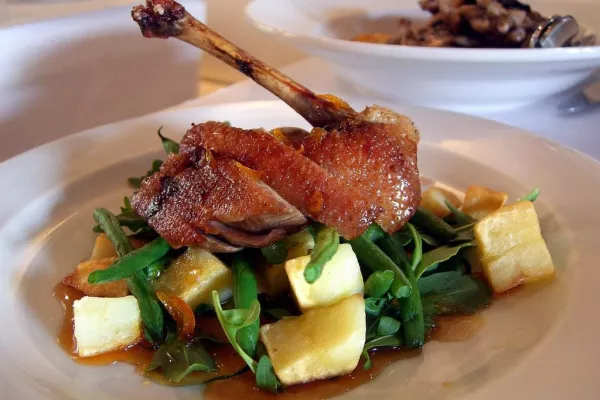According to just about everybody, the future of dining can be summed up in two words: fast casual.
But before you imagine your world full of nothing but chicken tenders and kale caesar salads, I’d like to direct you to a contrary trend—the rise of old-fashioned cooking tools and methods, along with a focus on things that take time.
Specifically, I’d like to introduce you to the duck press, a tool dating back to the 1880s that has surfaced at such top New York restaurants as Daniel, Per Se, La Grenouille, and Shun Lee Palace and is probably making a comeback at the reinvented Four Seasons, too.
Made famous in the 19th century by the grandest of grand restaurants, La Tour d’Argent in Paris, the recipe for pressed duck calls for essentially one ingredient—duck, duh—and one key piece of equipment.
What Is It?
Standing some two feet tall and weighing in at about 20 pounds, the duck press is a very specialized thing. It’s used to press the blood from the bones and internal organs of a duck, which is then stirred into the sauce that’s spooned over the roasted bird. While it might sound like something from Bizarre Foods, the result is quite delicious—the blood thickens and enriches the sauce, adding a singularly earthy umami flavor. It’s the poultry equivalent of a perfect black-and-blue steak, though more intense and flavorful.
The duck press itself looks like a torture device, albeit a beautiful one. Some presses have claw feet like those on an old-school tub; all are topped with a wheel and screw mechanism to press down and extract the blood from meat and bones. They’re available on EBay; you'll want one of the great antique presses, which start around $2,000. You will find a duck press in approximately zero home kitchens, yet the sight of one will evoke images of stupendous, Downton Abbey-style, white-tie dinner parties for those who know.
Who Uses a Duck Press?
At the fine dining bastion, Daniel, on Manhattan’s Upper East Side, chef and owner Daniel Boulud has installed one in his kitchen. (Rapper Action Bronson tested it out.) Rumor has it that the Carbone team's much-anticipated Grill, which will take the original place of the Four Seasons, will feature a pressed duck-style dish.
The reigning duck press champion, however, has to be Laurent Gras. He’s been called “ounce for ounce, the best chef in the world” by Momofuku’s David Chang, and his résumé counts stints in the kitchens of several of the world’s legendary French chefs, including Guy Savoy, Alain Senderens, and Alain Ducasse, whom he helped win three Michelin stars. It was at Paris restaurant Lucas Carton that Gras first used a duck press in the early '90s, becoming so obsessed that he bought his own in a Paris antique shop for about $200. Later, when he became chef de cuisine at Louis XV in Monte Carlo, he employed one to make a version of the dish with lobster, pressing the juices from the head for a sauce to coat the poached tail and claw meat.
In the way that crafting a perfect omelet or loaf of bread is the test of a great chef, Gras considers pressed duck his masterpiece.
“Essentially, you’re making roast duck in sauce. It just takes about 30 steps to do it,” he said. “It’s one of the most unique preparations in the world, and yet it’s only duck.”
Testing the Press
One recent morning, Gras, who is doing a series of pop-ups around New York, brought his cherished duck press to Bloomberg’s Manhattan office to create the dish for a select group.
The process started several days earlier: Gras ordered ducks from a special supplier in Canada, which he finds produces the most flavorful birds. He dried them in a refrigerator for two weeks before cooking, which both concentrated the flavor as the moisture evaporated and tenderized the meat as muscles broke down. Even if it’s not destined for the duck press, he said, a duck merits sitting for a few days before cooking. “Fresh duck is not a selling point to me,” advised Gras. “It will always be tough.”
Gras browned the whole bird on its leg and breast sides, and then roasted it for about 15 minutes in two consecutive cycles, letting it sit halfway to keep moist. He carved the duck, setting aside the meat for plating and pouring any juices into a bowl.
“Every drop of blood and juice is precious now,” he said, adding that the process makes him feel a little bit like Dr. Frankenstein. Gras transferred the cut-up remnants and odd bits of duck into the duck press and started pressing.
This is harder than it might seem; it takes effort to turn the wheel. Once he got it moving, it was exciting to see a steady, if modest, stream of blood start to flow. Gras then stirred the blood into a sauce made from roast garlic, duck liver, and foie gras mousse, plus chicken stock he had brought to cook with duck legs, and duck bones, to pump up the stock’s flavor. (The additional duck legs will provide a great dinner on another night.). Gras's surprise ingredient was a little bittersweet chocolate. He is not into adding unconventional flavors to his duck sauce—he made a face when Szechuan peppercorns were mentioned—but he did allow that modest orange, chiles, or cognac can be added to the sauce. “Black truffles get people’s attention, too,” he said, smiling.
After about three hours in our test kitchen, the pressed duck was done—although Gras said that, in a restaurant setting, he would add five hours to the entire process (with more time for resting) to achieve even more ethereal results. Still, our results were incredible: meaty, gamy slices of duck breast and the whole duck legs, with outrageously crispy skin. Most important was a deep, dark-brown sauce, as thick as custard, with a luxuriously rich, sweet, earthy flavor and the texture of soft velvet.
News by Bloomberg, edited by Hospitality Ireland









